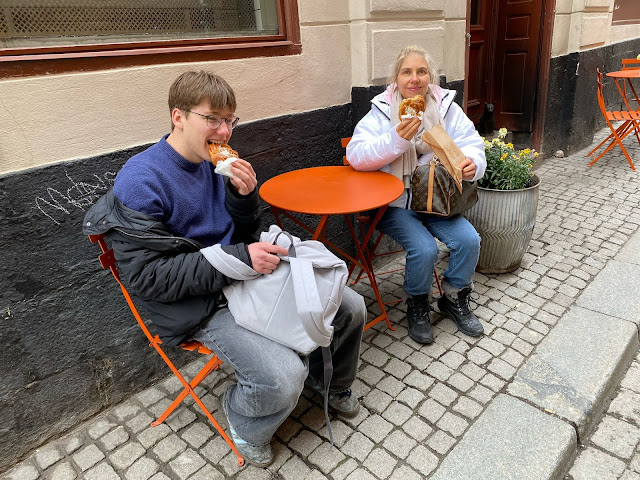Hello UBC buddies, it's halftime! Time for a treat!
When I was in Stockholm, I felt like there was a bageri (Swedish for bakery) on every corner, especially in the cobblestoned alleys of the old town, Gamla Stan. I was so sure of this impression that I set out to confirm it with stats… and was genuinely surprised by what I found.
Turns out, Stockholm doesn’t have an especially high number of bakeries per capita. In fact, compared to Zurich - "my" city - the bakery density is significantly lower. And yet, typical bakeries seem to be disappearing from Zurich’s cityscape, while in Stockholm, they felt vibrantly present and thriving. So what gives?
Why Stockholm feels like Bakery Heaven (Even if Stats say otherwise)
Curious, I dug a little deeper to understand the seeming contradiction. Here’s what I found:
1. Concentration in Tourist Areas
Historic centers like Gamla Stan have a high density of cafés, bakeries, and specialty shops that cater to both locals and tourists. So while the city-wide average may be moderate, key walkable neighborhoods feel packed with cozy places offering baked goods.
2. The Swedish “Bageri” Vibe
A Swedish bageri is often a charming artisan shop, somewhere between a bakery and a café. Many are small, stylish spots with rustic buns, sourdough loaves, and strong coffee. They’re usually in visible, pedestrian-friendly areas, not tucked into supermarkets or hidden behind display counters, as in other cities.
3. Population Spread
Stockholm has a lot of suburban areas, so its overall population is spread across a large area. That dilutes the per capita bakery count. But in the walkable urban core, the density is higher, and that’s what visitors like me notice most.
4. Fika Culture
I wrote a separate post about fika, so you already know that Sweden’s beloved coffee-and-pastry break supports a bakery-rich café culture. Not all fika spots are bakeries, but many bakeries double as cafés, or at least sell excellent coffee alongside their buns and breads.
More than just Buns: What you’ll find in a Swedish Bageri
Sure, kanelbullar (cinnamon buns) and kardemummabullar (cardamom buns) are everywhere, but Swedish bakeries offer much more than sweet treats.
You'll also find hearty, everyday staples like:
Rågbröd (rye bread): dense, dark, and full of flavor
Knäckebröd (crispbread): the crunchy pantry essential
Frallor: soft bread rolls, often topped with seeds or whole grains
Semlor: seasonal cream-filled buns sold in winter
Prinsesstårta: the iconic green-marzipan layer cake
A Word on the Princess Cake:
Each year, the Association of Swedish Bakers & Confectioners hosts a national "Princess Cake Week," during which participating cafés and bakeries donate 2.50 SEK (about 25¢) per princess pastry and 10 SEK (roughly $1 USD) per whole cake to Crown Princess Victoria’s fund. (More about that in my post on the Swedish monarchy.)
And of course, no proper Swedish bageri is complete without all the fixings for a classic smörgås, (Swedish for “sandwich”) refers to an open-faced creation, often served on buttered rye or crispbread. Think of it as the Swedish cousin to Denmark’s smørrebrød , layered with gravad lax, boiled eggs, cheese, shrimp salad, or a little of everything. Humble, hearty, and delicious.
.jpg) |
| Photo Credit: Infomastern (Susanne Nilsson) |
Cardamom, Craft, and Culture: What makes Stockholm’s Bakeries special
Stockholm’s bakeries strike a perfect balance between tradition and trend, offering everything from rustic sourdough loaves to delicate cardamom buns in stylish, minimalist spaces.
While internationally known names like Fabrique, famous for its traditional stone-oven sourdough and with outposts in London and New York, have helped put Swedish baking on the global map, Stockholm is also home to beloved local spots like the classic Vete-Katten and waterfront Skeppsbro Bageri.
Do you think the feel of a place can outweigh the numbers?




Stockholm looks like an amazing place to visit! I have been learning a lot from your posts! I just did a Google search for vegan bakeries in Stockholm and found bakeries with vegan options! I hope to travel there one day!
ReplyDeleteI'm assuming that Swedes have less of a sweet tooth than elsewhere - I remember you saying that the cinnamon buns weren't as sweet as the US. Myself, I prefer the cafe style bakery that does more breads and sandwhiches over the sweet.
ReplyDeleteIt made me hungry reading this. I haven't frequent bakeries as such, getting baked goods in bakery part of grocery store. Boring! I should be more venturesome and explore real bakeries.
ReplyDeleteStockholm really does give off “bakery on every corner” energy—even if the numbers say otherwise! Love how fika culture and cozy bagerier make the city feel so sweet and welcoming.
ReplyDeleteI need to try rye bread and the princess cake.The fika culture is adorable. I am now planning my own bakery hop post.
ReplyDelete